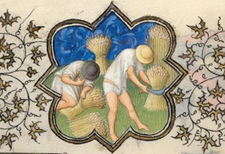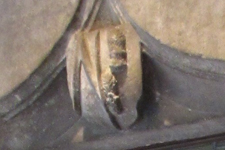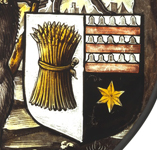At certain times of the year in the medieval rural landscape, it would have been common to see plump sheaves of grain standing in sunny fields like so many golden tokens of agricultural wealth and prosperity, as numerous depictions???even in some of the most sumptuous manuscripts of the Middle Ages, such as the Belles Heures of the duke of Berry???attest. At harvest, the wheat was cut at the base of the stalk with a sickle and then gathered up in large armfuls and tied about the middle. The resulting bundles were left spaced and standing upright in the fields, which allowed them to dry even if it happened to rain before they could carted off for threshing.
Details of illuminations from Folio 8r and Folio 9r from the Belles Heures of Jean de France, duc de Berry, 1405???1408/9.
It’s not surprising that these signs of prosperity appear frequently in the fields of heraldry. (For more about heraldry, see my first post on the subject, “The Garden in Heraldry,” April 26, 2010). Roses may be lovely and sweet, but it was the golden produce of the fields, after all, that helped make those gentle garden bowers possible, and many families were happy to place fat sheaves of grain on their shields. The Cloisters’ collection includes two such heraldic depictions, one from a limestone window and the other from a glass roundel.
Left: Detail of a shield from a late fifteenth-century window; Right: Detail of a shield from a glass roundel. Unfortunately, the owners of these shields have not been identified.
In heraldry, sheaves are known as “garbs,” a word that has fallen out of use in today’s English. While garbs are most frequently tinctured Or (”gold” or “yellow” in blazon, the language of heraldry) and assumed to represent wheat, they can also signify sheaves of rye, barley, or even oats. These alternate grains may be selected in order to make a word play on a family name (such as the garbs of rye of the Riddells) or other references (such as the barley garbs in the arms of the Worshipful Company of Brewers (see image). In heraldic descriptions, the ties that appear around the middle of the garbs are assumed to be the same color as the garb, unless otherwise stated.
Some interesting garbs occur in the arms of the various Comyn families of Scotland (see image). Because of the name, it’s often speculated that the garbs are not intended to be grain at all but rather to represent bundles of cumin (Cuminum cyminum). Cumin is an annual herb of the same family as carrots, parsley, and caraway, the seeds of which often make an appearance in rye bread. However, like so many supposed origins in heraldry, this story may be no more than a quaint tale. Certainly there would have been less ambiguous ways of depicting cumin.
A golden garb was involved in the resolution of one of the most famous heraldic disputes of the Middle Ages. During an English military campaign against Scotland in 1385, Sir Robert Grosvenor, a minor knight from Cheshire, and Sir Richard le Scrope, baron of Bolton, discovered that they were using the same arms, Azure a Bend Or (see image). The High Court of Chivalry was called into session to settle the dispute. Evidence of ancient use was assembled and several notable witnesses???including John of Gaunt, duke of Lancaster; Owain Glynd??r, later last native prince of Wales; and a certain writer and royal clerk named Geoffrey Chaucer???gave evidence for the well-connected Scrope, who was variously King Richard II’s Lord High Treasurer, Keeper of the Great Seal, and Lord Chancellor. The case lasted five years and was only settled after the king himself passed judgment on the outcome. Defeated, Grosvenor finally took up Azure a Garb Or instead (see image), and although he would certainly have been miffed after such a long and valiant struggle, I can’t help feeling that he came away the victor, with a rich, golden garb in a place of honor where only a simple gold stripe had been before. Today the Grosvenors are dukes of Westminster; perhaps the garb brought them good luck.
???R. Theo Margelony, Departmental Coordinator, Department of Medieval Art and The Cloisters
Further Reading
Fox-Davies, A. C. A Complete Guide to Heraldry, London: 1909. Revised edition: J. P. Brooke-Little, London: Thomas Nelson & Sons, 1969
Franklyn, J. Shield and Crest, London: MacGibbon and Kee, 1960
Squibb, G. D. The High Court of Chivalry: A Study in the Civil Law of England, Oxford University Press, 1959
Tags: barley, Belles Heures, blazon, Bolton, caraway, carrot, Cheshire, Comyn, cumin, Cuminum cyminum, garb, Geoffrey Chaucer, gold, grain, Grosvenor, heraldic, heraldry, John of Gaunt, oat, Owain Glynd??r, parsley, rye, Scrope, sheaf, sheaves, shield, wheat





August 13, 2011 at 12:55 am
Extraordinarily informative and entertaining.